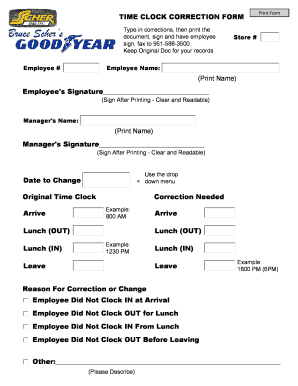The Time Clock Correction Form Template You Need Right Now: Streamline Your Payroll and Save Time
Are you tired of payroll headaches caused by inaccurate employee time clock entries? Do you find yourself spending countless hours manually correcting errors and chasing down missing information? You’re not alone. Inaccurate timekeeping is a widespread issue, but thankfully, it’s a problem that can be effectively managed with the right tools, starting with a well-designed time clock correction form template.
This article delves into the importance of time clock correction forms, provides insights on what to include, and offers a free template to help you streamline your payroll processes and save valuable time. Whether you’re a small business owner or a seasoned HR professional, this guide will equip you with the knowledge and resources to create a more efficient and accurate timekeeping system.
Why You Need a Time Clock Correction Form
In today’s fast-paced business environment, every minute counts. Inaccurate timekeeping can lead to a cascade of problems, including:
- Payroll Errors: Incorrectly calculated wages can lead to overpayment, underpayment, and potential legal issues.
- Employee Dissatisfaction: Errors in paychecks can damage employee morale and trust.
- Compliance Risks: Failure to accurately track and compensate employees according to labor laws can result in penalties and legal repercussions.
- Wasted Time: Manually correcting time clock errors consumes valuable time that could be spent on more strategic tasks.
- Increased Overhead: The administrative burden of correcting errors adds to your overall operating costs.
A well-structured time clock correction form acts as a crucial bridge between the timekeeping system and the payroll process. It provides a standardized method for employees to report errors, ensuring that corrections are made consistently and accurately.
Essential Elements of a Time Clock Correction Form Template
A robust time clock correction form should be clear, concise, and easy for both employees and administrators to use. Here’s a breakdown of the essential elements you should include:
- Employee Information:
- Employee Name
- Employee ID (if applicable)
- Department
- Date of the Time Clock Error
- Error Details:
- Original Clock-In Time
- Original Clock-Out Time
- Reason for the Correction (e.g., forgot to clock in/out, incorrect time entered) – Be sure to provide clear, pre-defined options, and allow for an “Other” field for specific scenarios.
- Corrected Clock-In Time
- Corrected Clock-Out Time
- Total Hours Worked (Calculated Automatically)
- Authorization and Signatures:
- Employee Signature (verifying the accuracy of the correction)
- Supervisor Signature (approving the correction)
- Date of Submission
- Additional Notes (Optional):
- A space for additional comments or explanations.
Creating Your Own Time Clock Correction Form Template
You can create a time clock correction form using various tools:
- Microsoft Word or Google Docs: These programs are readily available and provide basic formatting options. You can easily create tables and add fields for the necessary information.
- Microsoft Excel or Google Sheets: Spreadsheets allow for automatic calculations, such as total hours worked, reducing the risk of manual errors.
- Dedicated HR Software: Many HR software solutions include integrated timekeeping and correction features. This streamlines the process even further.
[Downloadable Template Link - Replace with your actual downloadable template link, if available ]
[Image of a Sample Time Clock Correction Form - Replace with an actual image of your form ]
Best Practices for Implementing a Time Clock Correction System
- Clearly Communicate the Process: Educate employees on how to use the form and the importance of accurate timekeeping.
- Make Forms Accessible: Provide easy access to the form – whether it’s a physical copy or a digital version accessible through your company intranet or HR software.
- Establish a Clear Approval Process: Outline who is responsible for approving corrections and the timeframe for processing them.
- Track and Analyze Errors: Regularly review time clock correction forms to identify patterns and areas for improvement in your timekeeping system. This could highlight training needs or systemic issues.
- Regularly Update the Form: Review your form periodically to ensure it remains relevant and meets your organization’s needs.
Conclusion: Mastering Timekeeping for a More Efficient Business
Implementing a well-designed time clock correction form template is a crucial step towards streamlining your payroll process, reducing errors, and saving valuable time. By understanding the essential elements of a correction form and following best practices for implementation, you can create a more efficient and accurate timekeeping system that benefits both your employees and your business. Take control of your timekeeping, minimize errors, and focus on what matters most: growing your business.
Frequently Asked Questions (FAQs)
1. How often should I review time clock correction forms?
Regularly reviewing these forms, at least monthly, is recommended. This allows you to identify trends, address recurring errors, and proactively improve your timekeeping processes.
2. What if an employee refuses to sign the correction form?
If an employee refuses to sign, document the situation, including the reason for refusal. Consult with your HR department and/or legal counsel to determine the appropriate course of action, which may include providing a witness or alternative documentation.
3. Can I use an electronic time clock correction form?
Yes, electronic forms are often preferred for their convenience and efficiency. They can be easily accessed, completed, and submitted electronically, reducing paper waste and streamlining the approval process. Make sure the electronic forms are compliant with your data security policies.
4. Should I keep a record of time clock correction forms?
Absolutely! Keep all completed time clock correction forms for a period as required by your legal and compliance obligations. This documentation is essential for payroll audits and potential legal disputes.
5. What if there are frequent time clock errors?
If you observe a high frequency of errors, consider retraining employees on proper timekeeping procedures, investing in a more user-friendly time clock system, or addressing any underlying issues that may be contributing to the errors.




